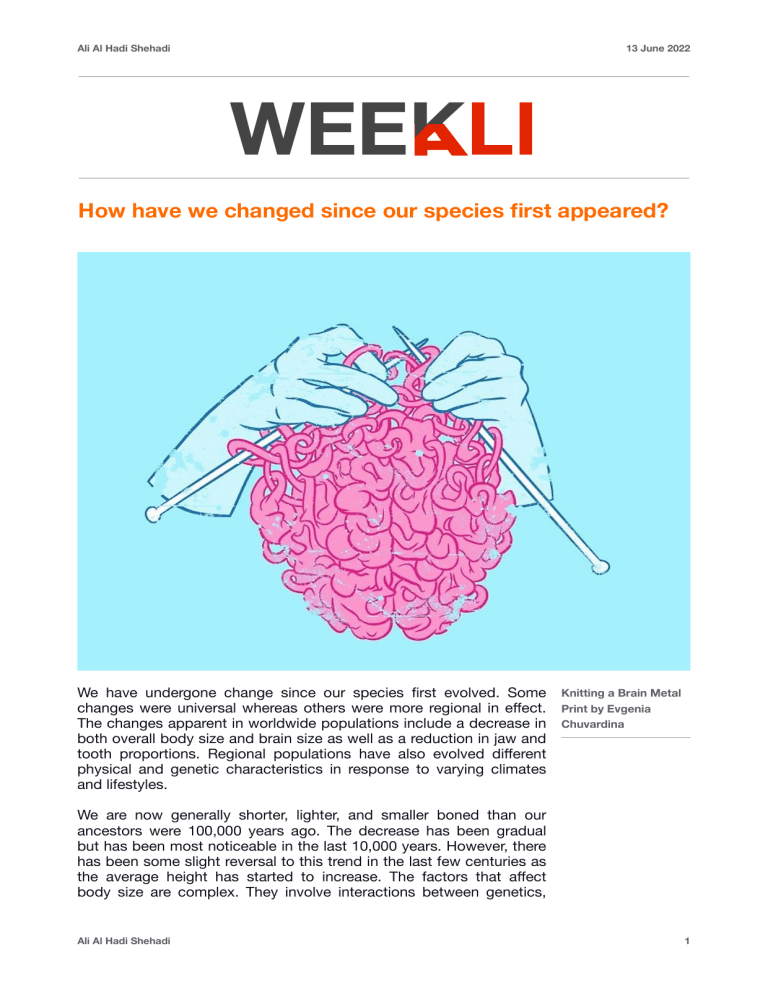
Ali Al Hadi Shehadi 13 June 2022 - WEEKLI How have we changed since our species rst appeared? We have undergone change since our species rst evolved. Some changes were universal whereas others were more regional in e ect. The changes apparent in worldwide populations include a decrease in both overall body size and brain size as well as a reduction in jaw and tooth proportions. Regional populations have also evolved di erent physical and genetic characteristics in response to varying climates and lifestyles. Knitting a Brain Metal Print by Evgenia Chuvardina We are now generally shorter, lighter, and smaller boned than our ancestors were 100,000 years ago. The decrease has been gradual but has been most noticeable in the last 10,000 years. However, there has been some slight reversal to this trend in the last few centuries as the average height has started to increase. The factors that a ect body size are complex. They involve interactions between genetics, ff ff fi ff 1 fi Ali Al Hadi Shehadi 13 June 2022 environment, and lifestyle practices such as diet and technology. For the last two million years there has been a trend toward a bigger brain that has a ected many species in our family tree. This trend has seen a reversal in our species and our brains are now the smallest they have been at any time in the past 100,000 years. Most of this decrease occurred in the last 6,000 years. In part, this is related to a decrease in body size that also occurred during this period, however, other factors are probably also involved. Our brains now average about 100-150 cubic centimeters less than when our species rst appeared. Humans today show an enormous diversity in appearance, however, this diversity was not apparent in early Homo sapiens. Early members of our species lived in Africa and had evolved physical characteristics that were similar to each other in order to survive in that climate. When humans started to spread to di erent parts of the world about 100,000 years ago, they encountered a variety of di erent climatic conditions and evolved new physical adaptations more suitable to those new climates. Neurons Painting by Michael Clague Recent DNA studies (since 2007) con rm that genetic traits have changed or adapted to new environments during this time. The rate of change of DNA, and thus the rate of evolution, has accelerated in the last 40,000 years. Areas of the human The oak is the genome still seem to be undergoing strongest tree in the selection for things such as disease and skin color. It also appears that some forest, but the physical features have been inherited from willow bends and interbreeding with other ancient human adapts. When the species. An international team, led from res and storms hit, CL, Aix-Marseille University, and the Open it is the willow that University, found that the gene TBX15 was linked with genes found in ancient survives. Denisovans, providing a clue to the origin of the gene in our species. This gene helps -KARA BARBIERI determine lip shape via body fat distribution and may have been useful to Denisovans in the cold climates of their Central Asian homelands. In conclusion, physical characteristics such as skin and eye color, hair type, color, and body shape are determined by genetics, but can also be in uenced by the environment. Over long periods, the environment will act on the genes to develop particular characteristics within a population. fi fi 2 ff fl ff Ali Al Hadi Shehadi ff fi Ali Al Hadi Shehadi


